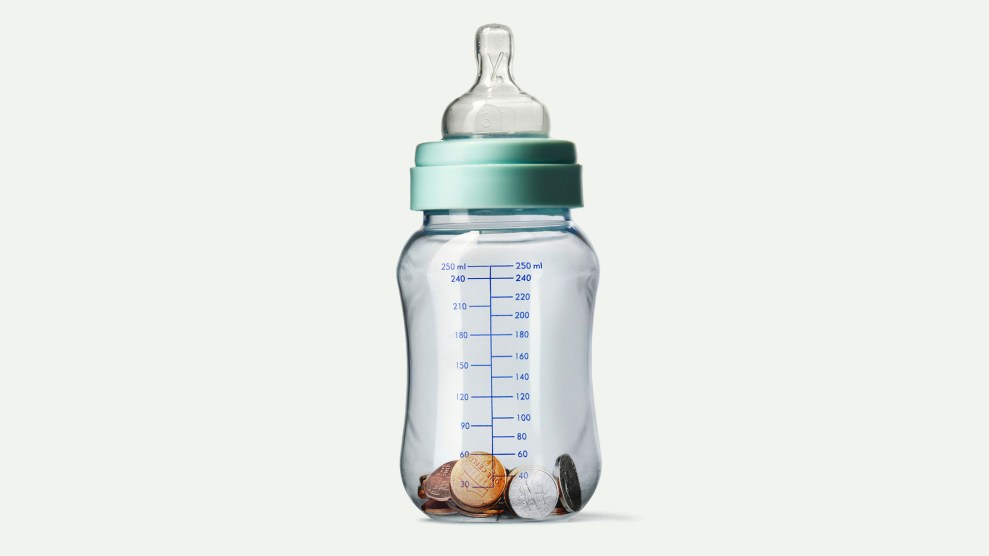
Mother Jones; Getty
In any given month, about 1.63 million women, 1.71 million infants, and 3.52 million children under the age of 5 receive federal food assistance from a program colloquially known as WIC.
Among the recipients of that aid is the 3-year-old daughter of Emily Church in Athens County, Ohio. Three years ago, when her daughter was born, Church wasn’t producing a sufficient volume of breast milk and her income made special formula hard to swing on her own, so the Special Supplemental Nutrition Program for Women, Infants, and Children (WIC) uploaded coupons to a debit-like card that completely covered multiple kinds, allowing her family to find the formulation that worked best for their baby’s stomach.
Now that Church’s daughter is a toddler, that WIC card pays for fruits and vegetables, milk, whole wheat bread, cereal, eggs, juice, and peanut butter, amounting to an estimated $60-90 off Churchs’ grocery bill every two weeks.
The extra money doesn’t allow Church to indulge in self-care splurges like manicures or massages, says the mom, a 41-year-old sales manager at a dairy company who is also studying to become an elementary school teacher. “It’s just making sure that I can more easily pay the water bill each month,” she says.
Even that may soon be a luxury. After months of congressional squabbling over funding the government, the three short-term spending bills Congress has so far passed have effectively put the WIC program in the red. If Congress does not pass a permanent funding bill with $1 billion in additional funding for WIC soon, the program’s administrators in all US states and territories are expected to put pregnant and postpartum women and their children on waiting lists. It would be the first time in roughly 25 years that the 50-year-old program was not fully funded to serve all eligible applicants.
The Center on Budget and Policy Priorities, a center-left think tank in Washington, estimated in December that approximately 2 million young children, pregnant adults, and postpartum adults would be forced off the program or denied access to it by September if Congress doesn’t appropriate the $1 billion budget increase.
At risk, experts say, are children’s’ growth and educational performance, the future stability of household budgets already stretched thin, and even the livelihoods of farmers, whose bottom lines have been strengthened by an estimated $1.3 billion annually, thanks to the sales of the minimally processed goods WIC subsidizes, like milk and eggs.
WIC’s potential budget shortfall, says Nell Menefee-Libey, senior public policy manager for the nonprofit National WIC Association, is “unprecedented in this millennium,” adding that for two-and-a-half decades, “there’s been a bipartisan commitment among Congress and the White House to treat WIC like a mandatory program, even though we’re discretionary funding.”
The federal commitment to funding the nutritional needs of pregnant women, new mothers and young children stemmed from a 1969 White House Conference on Food, Nutrition and Health—led by one Richard Nixon.
“Malnutrition is a national concern because we are a nation that cares about its people, how they feel, how they live,” then-President Nixon said. “This nation cannot long continue to live with its conscience if millions of its own people are unable to get an adequate diet.”
Based on a program recommended by conference attendees, WIC started as a pilot program in 1972. Five decades later, it serves 6.3 million people in low-income families every month, including roughly 40 percent of all newborn infants, as well as pregnant people, postpartum people up to six months after childbirth, and breastfeeding people up until their child’s first birthday.
Scientific studies have shown WIC participation results in fewer infant deaths and fewer premature births. WIC participation is also correlated with lower health care costs. Nixon discussed these advantages more than 50 years ago.
“A child ill-fed is dulled in curiosity, lower in stamina, distracted from learning. The mounting cost of medical care for diet-related illnesses, remedial education required to overcome diet-related slowness in school, institutionalization and loss of full productive potential—all of these place a heavy economic burden on a society as a whole,” Nixon said at the 1969 conference, the first one he led as president.
Outside of the food benefit, WIC also provides nutrition-related health referrals and guidance to recipients. Pregnant people are taught about the benefits of breastfeeding and how to increase their chances of a full-term pregnancy, says Stephanie Bess, an associate director in the family wellness office of the Illinois Department of Human Services. “Without WIC, our families may not get connected to a health care provider, which, for instance, would impact their ability to know their child has low hemoglobin–impacting their ability to learn,” she adds.
Multiple factors have led to the program’s current predicament. Food costs for the program are rising, both from general inflation and because WIC has increased the amount that families can put toward fresh fruits and vegetables in recent years.
Meanwhile, WIC has begun allowing many required meetings between caseworkers and WIC recipients to be virtual, rather than in-person, a convenience which has made it easier for parents to sign up for WIC stay on the program longer.
Normally, Congress would supply the amount needed to keep WIC fully operations in annual appropriations bills. But in the three short-term funding bills passed this year, none have allotted the estimated $1 billion it will take to help every WIC-eligible applicant. The continuing resolution passed earlier this month gives Congress until early March to act.
In the interim, state WIC administrators have been told to act is if Congress will come through with the money they need to keep every eligible participant enrolled. If that extra $1 billion over last year’s appropriation doesn’t come through, states will likely have to reduce their recipient pools by tens of thousands to hundreds of thousands to stay under budget for the year.
“As we get deeper into the fiscal year, the potential impacts and the cuts that would need to be made to make up the shortfall get much bigger because they would have to be made over a shorter amount of time,” says Katie Bergh, a CBPP senior policy analyst.
California, for example, may have to put 288,000 people on waitlists, CBPP estimates. In Texas, 227,000 would lose benefits; in Illinois, 49,000 would.
It’s unlikely newborn babies would be affected. In the event of a budget shortfall, WIC recipients are classified by a federal priority system of seven categories. Generally, non-breastfeeding, postpartum people are classified as the lowest priority and would be terminated from the program first. Post-partum people with nutritional conditions are next-lowest priority, followed by older children, like Church’s daughter. Pregnant adults, breastfeeding adults, and infants are the highest priority to serve.
“There are only really a couple of levers available to state agencies in order to extract cost savings,” says Menefee-Libey. “And unfortunately, the one that has the largest potential to make up for a budget shortfall is to turn people away from the program for the first time in a generation.”

















